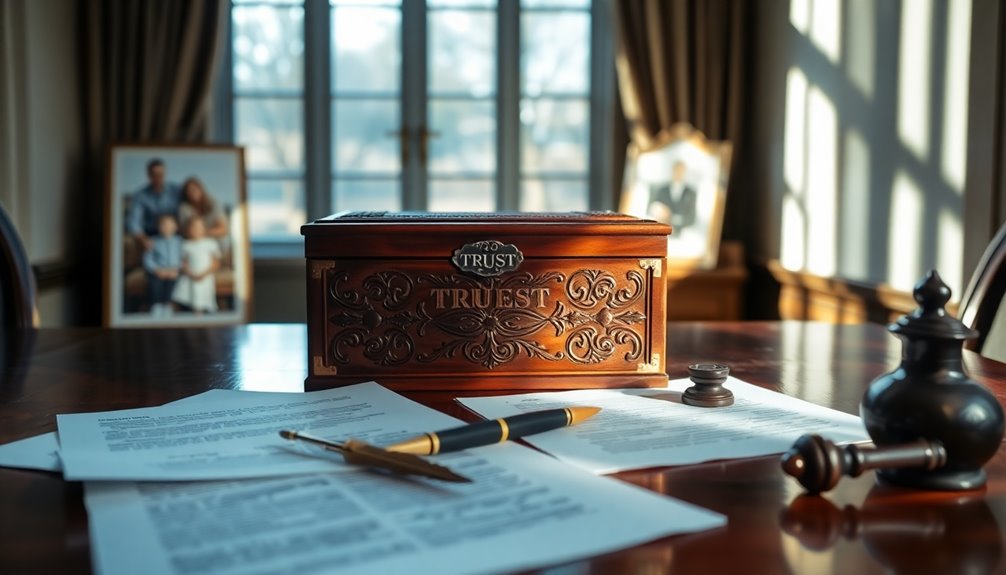You might be ignoring critical asset protection flaws that could put your financial security at risk. Relying solely on a will or trust isn't enough to shield your assets from costs like nursing home expenses. Plus, transferring assets carelessly can lead to Medicaid ineligibility and hefty tax burdens. It's crucial to have effective strategies in place. Discover key precautions and strategies to better protect your assets.
Key Takeaways
- Relying solely on a will or living trust does not protect against Medicaid recovery and nursing home costs.
- Transferring assets to relatives can result in Medicaid ineligibility and unintended tax consequences.
- Joint ownership may expose your assets to creditors rather than providing the expected protection.
- Properly setting up trusts and choosing the right trustee is crucial for effective asset protection.
- Regularly auditing and updating your asset list helps mitigate vulnerabilities and aligns with current risks.
Common Asset Protection Mistakes to Avoid

When it comes to asset protection, many people unknowingly make critical mistakes that can jeopardize their financial security. Relying solely on a will or living trust isn't enough; these don't shield your assets from Medicaid recovery or nursing home costs. Medicare and health insurance also fall short, as they don't cover long-term care expenses, which can soar above $7,000 monthly. Additionally, average nursing home costs can quickly deplete your life savings without a solid plan in place. Transferring assets to relatives can lead to lengthy Medicaid ineligibility and tax consequences. Additionally, joint ownership mightn't provide the protection you think it does. It's vital to seek specialist advice; inadequate planning can burden your family and expose you to significant financial risks. Don't wait too long—timing and proper funding are crucial for effective asset protection.
The Importance of Proper Trust Setup

Establishing a properly set up trust is crucial for effective asset protection and estate planning. An asset protection trust shields your assets from creditors and legal actions, providing security for your beneficiaries. Since these trusts are irrevocable, once you transfer assets, you can't remove them, so careful planning is essential. Choosing the right trustee is vital, as they'll manage your assets according to the trust's terms. It's also important to designate beneficiaries clearly to ensure your wishes are followed. Consulting with financial advisors and estate planning attorneys helps navigate legal requirements that vary by state. Additionally, incorporating inflation protection strategies into your financial planning can further safeguard your assets against economic fluctuations. Ultimately, a well-structured trust not only protects your assets but also streamlines the distribution process, avoiding probate complications. Additionally, maintaining a separate document for frequently used information enhances efficiency in managing trust details.
Understanding Digital Asset Vulnerabilities

Effective asset protection through trusts isn't just about legal frameworks; it also involves safeguarding your digital assets against various vulnerabilities.
You might be surprised to learn that over 64% of financial service companies have more than 1,000 sensitive files accessible to every employee. This data exposure, combined with the fact that 70% of sensitive data is considered stale, creates significant risks. Regularly making a list of important assets can help mitigate these vulnerabilities. Implementing insurance options can provide additional security against potential losses. Moreover, organizations should ensure that their employees receive regular training on data security best practices to further reduce the risk of breaches. As companies look to enhance their sustainability efforts, exploring innovative products such as biodegradable phone cases benefits could also play a role in improving their overall environmental footprint. By combining effective data management strategies with a commitment to sustainability, businesses can protect sensitive information while promoting a greener future.
Inconsistent permissions plague many organizations, with 58% noting over 1,000 folders with varying access rights. Alarmingly, only about 5% of folders are properly secured, and nearly 40% of companies have ghost users. Regular audits and a focus on identifying your critical digital assets are essential in addressing these vulnerabilities and enhancing your overall cybersecurity strategy.
Navigating Medicaid and Elder Law Complexities

How can you effectively navigate the complexities of Medicaid and elder law? First, understand Medicaid's strict asset limits, typically around $2,000. To qualify, you may need to employ asset protection strategies, like converting assets into income streams or using Medicaid Asset Protection Trusts (MAPTs). Be aware of the five-year look-back period, as improper asset restructuring can lead to penalties. Additionally, ensure you meet the medical necessity requirement to access nursing home care.
Elder law focuses on safeguarding your assets against long-term care costs and financial exploitation. Establish legal protections, such as powers of attorney, to address legal capacity issues. Medicaid planning strategies are essential in helping you structure your assets wisely to avoid unnecessary losses.
Proactive planning is crucial; getting started early can secure your benefits and protect your wealth.
Protecting Classified Information: Key Strategies

When protecting classified information, it's crucial to implement a range of strategies that ensure both physical and digital security. Start by organizing information using classification systems, tagging each piece to facilitate proper handling. Apply visual markings on documents to signal sensitivity and maintain a clear chain of custody to track access. For physical security, store classified materials in SCIF facilities and restrict access to authorized personnel only. Utilize secure storage solutions and monitor these areas with surveillance. Digitally, employ encryption protocols like AES-256, follow a zero trust architecture for access requests, and ensure communication through encrypted channels. Lastly, conduct regular security audits and provide employee training to reinforce awareness about security protocols, as redaction techniques play a vital role in safeguarding sensitive information against unauthorized access.
Strategic Planning for Effective Asset Protection

Strategic planning plays a pivotal role in safeguarding your assets against potential threats. To effectively protect your wealth, start by understanding asset protection fundamentals. This involves identifying critical assets, such as real estate and financial instruments, and assessing risks that could jeopardize them. Implement strategies like forming LLCs to shield personal liability and considering offshore asset protection trusts for added protection. Additionally, be aware that mandatory mediation can be an essential step in resolving disputes regarding asset division during a divorce.
Don't wait until a lawsuit is filed; early planning is vital. Regularly update your asset list, ensuring it reflects current circumstances and risks. Integrate your asset protection plans into your overall financial strategy, and consult with professionals for tailored advice. This proactive approach can significantly enhance your asset protection and secure your financial future.
Frequently Asked Questions
How Can I Assess My Current Asset Protection Strategy's Effectiveness?
To assess your current asset protection strategy's effectiveness, start by evaluating your assets, liabilities, income, and expenses.
Identify any vulnerabilities that could expose you to creditors or threats. Use tools like risk assessments and threat matrices to analyze potential risks.
Regularly review your strategy, ensuring it adapts to evolving circumstances.
Lastly, consulting with experienced asset protection attorneys can provide tailored insights to enhance your plan's effectiveness and safeguard your assets more effectively.
What Are the Tax Implications of Transferring Assets for Protection?
Imagine trying to shield your house from a storm, but forgetting to check the foundation.
When you transfer assets for protection, you need to consider tax implications like capital gains and gift taxes. If you inherit assets, they often get a stepped-up basis, while gifts retain the original basis.
Planning is key; it's like reinforcing that foundation to ensure you're secure from financial storms. Consulting a pro can help you navigate these complexities effectively.
Can Insurance Policies Be Part of My Asset Protection Plan?
Yes, insurance policies can definitely be part of your asset protection plan. By transferring financial risk to insurance companies, you mitigate potential losses from unforeseen events.
You should consider various types, like liability, umbrella, and professional liability insurance, to enhance your coverage.
However, remember that insurance alone won't guarantee complete protection. It's essential to combine these policies with legal structures and other strategies for a comprehensive approach to asset safeguarding.
How Often Should I Review My Asset Protection Plan?
How often should you review your asset protection plan?
Think of it like maintaining a garden; without regular care, it can quickly become overgrown. You should conduct annual reviews to ensure effectiveness and compliance with changing laws.
Additionally, any major life events—like marriage, divorce, or inheritance—signal a need for updates.
Don't forget to reassess after significant financial changes, ensuring your strategies stay relevant and robust against evolving risks.
What Role Does Estate Planning Play in Asset Protection?
Estate planning plays a crucial role in asset protection by ensuring your assets are managed and distributed according to your wishes.
It helps minimize taxes and legal complications while safeguarding your wealth from creditors and lawsuits.
By using legal mechanisms like trusts and LLCs, you can separate your personal assets from potential liabilities.
Regularly reviewing and updating your estate plan keeps it effective and compliant with changing laws, providing you peace of mind.
Conclusion
You might think you've got asset protection covered, but failing to address these critical flaws could leave you exposed. Just when you believe your trust is bulletproof, a digital vulnerability might sneak in, or a Medicaid misstep could cost you dearly. Remember, it's not just about having a plan; it's about the right strategy. By staying informed and proactive, you're not just protecting your assets; you're securing your peace of mind for the future. Don't let coincidence catch you off guard!
References
- https://lifelawfirm.com/estate-planning/top-10-asset-protection-mistakes/
- https://portal.cops.usdoj.gov/resourcecenter/content.ashx/cops-w0047-pub.pdf
- https://www.mckinsey.com/capabilities/risk-and-resilience/our-insights/protecting-your-critical-digital-assets-not-all-systems-and-data-are-created-equal
- https://www.dodig.mil/Portals/48/Documents/Policy/520001_vol3.pdf
- https://www.ricafortelaw.com/library/avoid-nyc-asset-protection-trust-mistakes.cfm
- https://www.energy.gov/sites/default/files/2018/02/f49/Hydropower-Vision-021518.pdf
- https://www.elderlawfirm.com/5-most-common-mistakes-with-asset-protection-youre-probably-making/
- https://nvlpubs.nist.gov/nistpubs/SpecialPublications/NIST.SP.1270.pdf
- https://blakeharrislaw.com/blog/asset-protection-mistakes-to-avoid
- https://avidianwealth.com/financial-insights/articles/how-to-set-up-asset-protection-trust/









